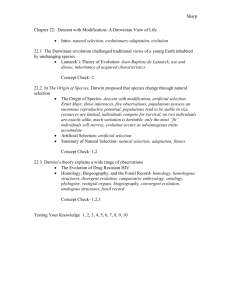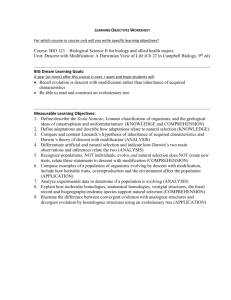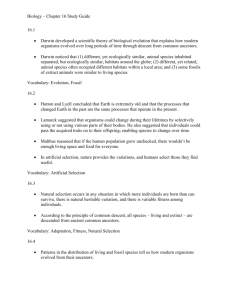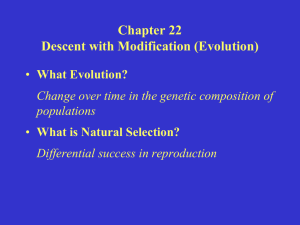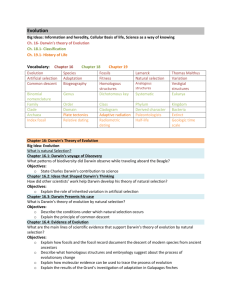Reading Guide: Chapter 9: Evolution
advertisement
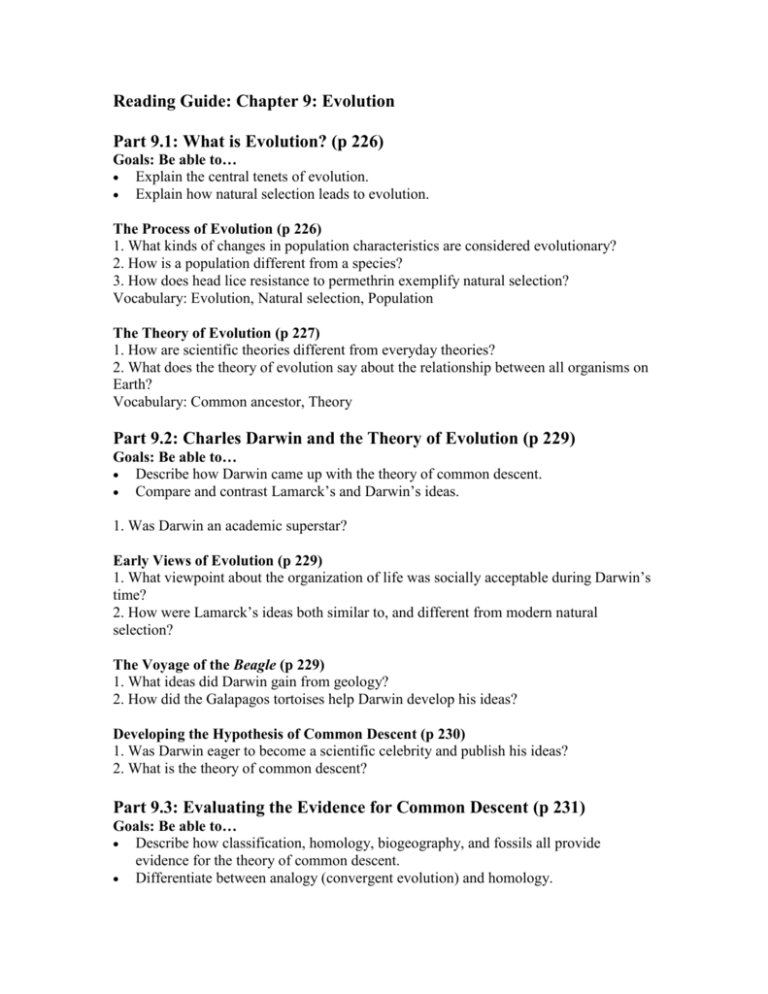
Reading Guide: Chapter 9: Evolution Part 9.1: What is Evolution? (p 226) Goals: Be able to… Explain the central tenets of evolution. Explain how natural selection leads to evolution. The Process of Evolution (p 226) 1. What kinds of changes in population characteristics are considered evolutionary? 2. How is a population different from a species? 3. How does head lice resistance to permethrin exemplify natural selection? Vocabulary: Evolution, Natural selection, Population The Theory of Evolution (p 227) 1. How are scientific theories different from everyday theories? 2. What does the theory of evolution say about the relationship between all organisms on Earth? Vocabulary: Common ancestor, Theory Part 9.2: Charles Darwin and the Theory of Evolution (p 229) Goals: Be able to… Describe how Darwin came up with the theory of common descent. Compare and contrast Lamarck’s and Darwin’s ideas. 1. Was Darwin an academic superstar? Early Views of Evolution (p 229) 1. What viewpoint about the organization of life was socially acceptable during Darwin’s time? 2. How were Lamarck’s ideas both similar to, and different from modern natural selection? The Voyage of the Beagle (p 229) 1. What ideas did Darwin gain from geology? 2. How did the Galapagos tortoises help Darwin develop his ideas? Developing the Hypothesis of Common Descent (p 230) 1. Was Darwin eager to become a scientific celebrity and publish his ideas? 2. What is the theory of common descent? Part 9.3: Evaluating the Evidence for Common Descent (p 231) Goals: Be able to… Describe how classification, homology, biogeography, and fossils all provide evidence for the theory of common descent. Differentiate between analogy (convergent evolution) and homology. Apply your knowledge of radiometric dating to problems. (Not on RAP quiz) Describe 3 ways in which evolutionary novelty can be generated by small changes. (Not on RAP quiz) 1. What do most biologists think about common descent? 2. Why don’t we present the idea of special creation in science classes? 3. What are 4 possible hypotheses about the relationships among organisms on Earth, and how do they differ from each other? Biological Classification Suggests Evolutionary Relationships (p 234) 1. What are some of the similarities between humans and other primates? 2. How do biologists categorize the diversity of life on Earth? 3. How does hierarchical classification of organisms suggest evolutionary relationships? Evidence of Homology (p 237) 1. How do the forelimb bones in mammals support the theory of common descent? 2. What are vestigial traits, and how do they support the theory of common descent? 3. What is the scientific explanation for why organism embryonic stages look so similar to each other? 4. How does molecular evidence support the theory of common descent? Vocabulary: Homology, Vestigial traits Evidence from Biogeography (p 262) 1. What can the geographical distribution of organisms tell us about their relationships to one another? 2. How is convergent evolution different from homology? Can you think of another example of convergent evolution amongst animals? Vocabulary: Convergent evolution Evidence from the Fossil Record (p 244) 1. Why don’t we have a complete fossil record of all the species that have ever lived? 2. What are the major differences between humans and other apes? 3. What process is the basis for radiometrically dating rocks? 4. If a rock is one half-life old, how much of the original radioactive element has turned into its daughter product? 5. Why is it incorrect to say that modern humans have evolved from modern chimpanzees? 6. What evidence in the fossil record supports the theory of common descent? Vocabulary: Daughter products, Half-life, Hominin, Radiometric dating Part 9.4: Are Alternatives to the Theory of Evolution Equally Valid? (p 250) Goals: Be able to… Discuss evidence refuting various alternative hypotheses of evolution. The Static Model and Transformation Hypotheses (p 250) 1. What evidence refutes the static hypothesis? 2. What evidence refutes the transformation hypothesis? The Separate Types and Common Descent Hypotheses (p 250) 1. What observations support the theory of common descent? The Best Scientific Explanation for the Diversity of Life (p 251) 1. What is another theory that scientists use? 2. Given all of the evidence presented in this chapter, do you think that other hypotheses should be taught to school children as valid alternatives to the theory of evolution? Why or why not?

